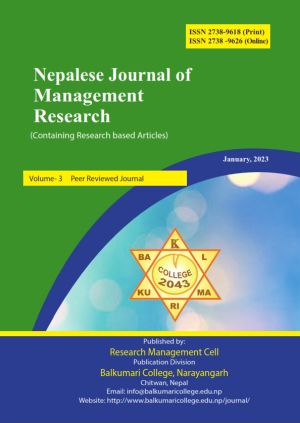VAT elasticity on Nepalese economy without agriculture
DOI:
https://doi.org/10.3126/njmgtres.v3i1.57910Keywords:
Elasticity, GDP, VAT, Remittances, Exchange rate, Market Capitalization, Money Supply, Government spendingAbstract
This paper seeks to examine the elasticity of Value added tax (VAT) on Nepalese economy without agriculture. It, therefore, analyzes the impact of VAT on GDP in aggregate level without agriculture. This study adopts explanatory research design and attempts to determine the relationship between VAT and the GDP, exchange rate, market capitalization money supply and government spending being the intervening variables included in the model.
In order for the specification of a model of cointegrated regression model with a time series data of the variables are employed for the study period of 20 years, from 1998/99 to 2017/18. The values of all the variables are converted into real price (constant price) by GDP deflator. The GDP deflator and CPI year 2013/14 have been assumed equivalent to the base year 2013/14 according to Nepalese fiscal year. Since it is observed that residuals are not normally distributed, autocorrelation and multicollinearity problem in the model, it is necessary to improve the non-normal distribution, autocorrelation and multicollinearity problem in the model. Therefore, the data are transposed into first difference and run the model with error correction model.
The diagnostic test suggests that the residuals do not violet classical assumptions. The lagged residuals from 5.7.2 equation of Table 5.9 are statistically significant indicating the acceptable ground to take variable as cointegrated set. The result allows long-run and short-run dynamics of all the relationship between GDPWA and VAT. The estimated coefficient of VAT in error correction model shows that one percent point rise in VAT has led to 0.438 percent point increase in real GDPWA in short-run, whereas it is found 0.558 percent point in long-run. It means that short-run marginal productivity of VAT is 0.438 percent point, whereas its long-run percent point is 0.558.
Downloads
Downloads
Published
How to Cite
Issue
Section
License
The journal allows the author to hold the copyright and retain publishing rights without restrictions.

